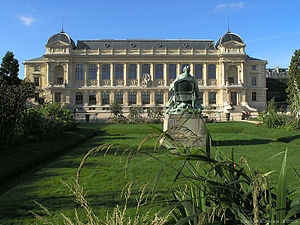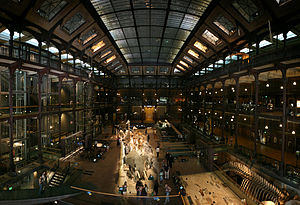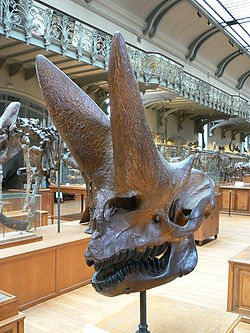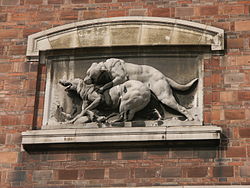- Muséum national d'histoire naturelle
-
The Muséum national d'Histoire naturelle (MNHN) is the National Museum of Natural History in Paris, France.
Contents
History
The museum was formally founded on 10 June 1793, during the French Revolution. Its origins lie, however, in the Jardin royal des plantes médicinales (Royal Medicinal Plant Garden) created by King Louis XIII in 1635, which was directed and run by the royal physicians. The royal proclamation of the boy-king Louis XV on 31 March 1718, however, removed the medical function, enabling the garden—which became known simply as the Jardin du Roi (King's Garden)—to focus on natural history.
For much of the 18th century (1739–1788), the garden was under the direction of Georges-Louis Leclerc, Comte de Buffon, one of the leading naturalists of the Enlightenment, bringing international fame and prestige to the establishment. The royal institution remarkably survived the French Revolution by being reorganized in 1793 as a republican Muséum national d'Histoire naturelle with twelve professorships of equal rank. Some of its early professors included eminent comparative anatomist Georges Cuvier and evolutionary pioneers Jean-Baptiste de Lamarck and Étienne Geoffroy Saint-Hilaire. The museum's aims were to instruct the public, put together collections and conduct scientific research. It continued to flourish during the 19th century, and, particularly under the direction of chemist Michel Eugène Chevreul, became a rival to the University of Paris in scientific research. For example, during the period that Henri Becquerel held the chair for Applied Physics at the Muséum (1892–1908) he discovered the radiation properties of uranium. (Four generations of Becquerels held this chairmanship, from 1838 to 1948.[1])
A decree of 12 December 1891 ended this phase, returning the museum to an emphasis on natural history. After receiving financial autonomy in 1907, it began a new phase of growth, opening facilities throughout France during the interwar years. In recent decades, it has directed its research and education efforts at the effects of human exploitation on the environment. In French public administration, the Muséum is classed as a grand établissement of higher education.
Mission and organization
The museum has as its mission both research (fundamental and applied) and public diffusion of knowledge. It is organized into seven research and three diffusion departments.[2]
The research departments are:
- Classification and Evolution
- Regulation, Development, and Molecular Diversity
- Aquatic Environments and Populations
- Ecology and Biodiversity Management
- History of Earth
- Men, Nature, and Societies, and
- Prehistory
The diffusion departments are:
- The Galleries of the Jardin des Plantes
- Botanical Parks and Zoos, and
- The Museum of Man (Musée de l'Homme)
The museum also developed higher education, and now delivers a master's degree.[3]
Location and branches
The museum includes sites throughout France, including the original location at the Jardin des Plantes in the 5th arrondissement of Paris (métro Place Monge). The galleries there include the Gallery of Mineralogy and Geology, the Gallery of Palaeontology and Comparative Anatomy, and the famous Grand Gallery of Evolution (Grande Galerie de l'évolution). The museum's Menagerie is also located here.
The herbarium of the museum, referred to by code P, includes a large number of important collections amongst its 8 000 000 plant specimens. The historical collections incorporated into herbarium, designated with its P prefix, include Lamarck's (P-LA) Desfontaines (P-Desf.) and Tournefort and Plumier (P-TRF). The designation at CITES is FR 75A. It publishes Adansonia, a botanical periodical, and journals on the flora of New Caledonia, Madagascar and Comores, Cambodia, Laos and Vietnam, Cameroon, and Gabon.[4]
The Musée de l'Homme is also in Paris, in the XVIe arrondissement (métro Trocadéro). It houses displays in ethnography and physical anthropology, including artifacts, fossils, and other objects.
Two zoos, the Parc zoologique de Paris (also known as the Zoo de Vincennes), at the Bois de Vincennes in the XIIe arrondissement, and the Parc zoologique de Clères, at a mediæval manor in Clères (Seine-Maritime), are also part of the museum, as is the Arboretum de Chèvreloup in Rocquencourt.
Chairs
The transformation of the Jardin from the medicinal garden of the King to a national public museum of natural history required the creation of twelve Chaired positions. Over the ensuing years the number of Chairs and their subject areas evolved, some being subdivided into two positions and others removed. The list of Chairs of the Muséum national d'histoire naturelle includes major figures in the history of the Natural sciences. Early chaired positions were held by Jean-Baptiste Lamarck, René Desfontaines and Georges Cuvier, and later occupied by Paul Rivet, Léon Vaillant and others.
In popular culture
The Gallery of Palaeontology and Comparative Anatomy and other parts of Jardin des Plantes was a source of inspiration for French graphic novelist Jacques Tardi. The gallery appears on the first page and several subsequent pages of Adèle et la bête (Adèle and the Beast; 1976), the first album in the series of Les Aventures extraordinaires d'Adèle Blanc-Sec. The story opens with a 136 million year old pterodactyl egg hatching, and a live pterodactyl escaping through the gallery glass roof, wreaking havoc and killing people in Paris. (The Gallery of Palaeontology and Comparative Anatomy returned the favor by placing a life size cardboard cutout of Adèle and the hatching pterodactyl in a glass cabinet outside the main entrance on the top floor balcony.)
Directors of the Museum
Directors elected for one year:
- 1793 to 1794 : Louis Jean-Marie Daubenton
- 1794 to 1795 : Antoine-Laurent de Jussieu
- 1795 to 1796 : Bernard Germain Étienne de Laville-sur-Illon, comte de Lacépède
- 1796 to 1797 : Louis Jean-Marie Daubenton
- 1797 to 1798 : Louis Jean-Marie Daubenton
- 1798 to 1799 : Antoine-Laurent de Jussieu
- 1799 to 1800 : Antoine-Laurent de Jussieu
Directors elected for two years:
- 1800 to 1801 : Antoine-François Fourcroy
- 1802 to 1803 : René Desfontaines
- 1804 to 1805 : Antoine-François Fourcroy
- 1806 to 1807 : René Desfontaines
- 1808 to 1809 : Georges Cuvier
- 1810 to 1811 : René Desfontaines
- 1812 to 1813 : André Laugier
- 1814 to 1815 : André Thouin
- 1816 to 1817 : André Thouin
- 1818 to 1819 : André Laugier
- 1820 to 1821 : René Desfontaines
- 1822 to 1823 : Georges Cuvier
- 1824 to 1825 : Louis Cordier
- 1826 to 1827 : Georges Cuvier
- 1828 to 1829 : René Desfontaines
- 1830 to 1831 : Georges Cuvier
- 1832 to 1833 : Louis Cordier
- 1834 to 1835 : Adrien de Jussieu
- 1836 to 1837 : Michel Eugène Chevreul
- 1838 to 1839 : Louis Cordier
- 1840 to 1841 : Michel Eugène Chevreul
- 1842 to 1843 : Adrien de Jussieu
- 1844 to 1845 : Michel Eugène Chevreul
- 1846 to 1847 : Adolphe Brongniart
- 1848 to 1849 : Adrien de Jussieu
- 1850 to 1851 : Michel Eugène Chevreul
- 1852 to 1853 : André Marie Constant Duméril
- 1854 to 1855 : Michel Eugène Chevreul
- 1856 to 1857 : Marie Jean Pierre Flourens
- 1858 to 1859 : Michel Eugène Chevreul
- 1860 to 1861 : Isidore Geoffroy Saint-Hilaire
- 1862 to 1863 : Michel Eugène Chevreul
Directors elected for five years:
- 1863 to 1879 : Michel Eugène Chevreul
- 1879 to 1891 : Edmond Frémy
- 1891 to 1900 : Alphonse Milne-Edwards
- 1900 to 1919 : Edmond Perrier
- 1919 to 1931 : Louis Mangin
- 1932 to 1936 : Paul Lemoine
- 1936 to 1942 : Louis Germain
- 1942 to 1949 : Achille Urbain
- 1950 to 1950 : René Jeannel
- 1951 to 1965 : Roger Heim
- 1966 to 1970 : Maurice Fontaine
- 1971 to 1975 : Yves Le Grand
- 1976 to 1985 : Jean Dorst
- 1985 to 1990 : Philippe Taquet
- 1994 to 1999 : Henry de Lumley
Presidents elected for five years:
- 2002-2006 : Bernard Chevassus-au-Louis
- 2006-... André Menez
See also
References
- ^ A. Allisy (November 1, 1996). "Henri Becquerel: The Discovery of Radioactivity". Radiation Protection Dosimetry 68 (1): 3–10. http://rpd.oxfordjournals.org/cgi/content/abstract/68/1-2/3.
- ^ Muséum national d'histoire naturelle; official website
- ^ Official website
- ^ Holmgren, P. K.; N. H. Holmgren. (1998 [updated: December 2008]). "Muséum National d'Histoire Naturelle". Index Herbariorum. The New York Botanical Garden. http://sweetgum.nybg.org/ih/herbarium.php?irn=125382. Retrieved 2009-03-10.
External links
Coordinates: 48°50′32″N 2°21′23″E / 48.842109°N 2.356286°E
- MNHN official website (English version)
- the Virtual Gallery of Mineralogy (English version)
- Popular and unofficial site (French only)
- Flickr Mostly Paris, some Lille.
- Photos of Muséum national d'histoire naturelle (English version)
Categories:- 1793 establishments in France
- Museums in Paris
- Natural history museums in France
- National museums of France
- Grands établissements
- 5th arrondissement of Paris
- Herbaria
- Dinosaur museums
Wikimedia Foundation. 2010.






